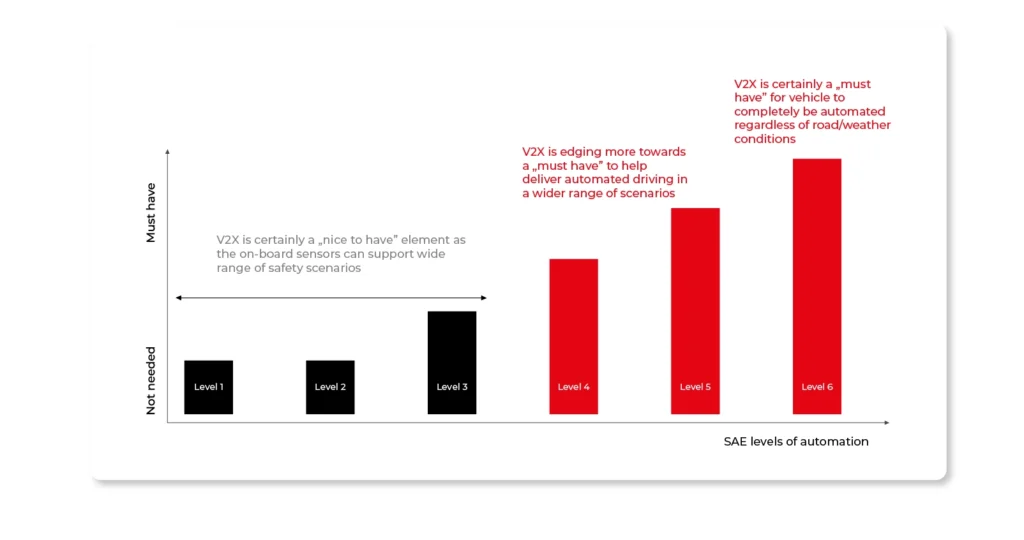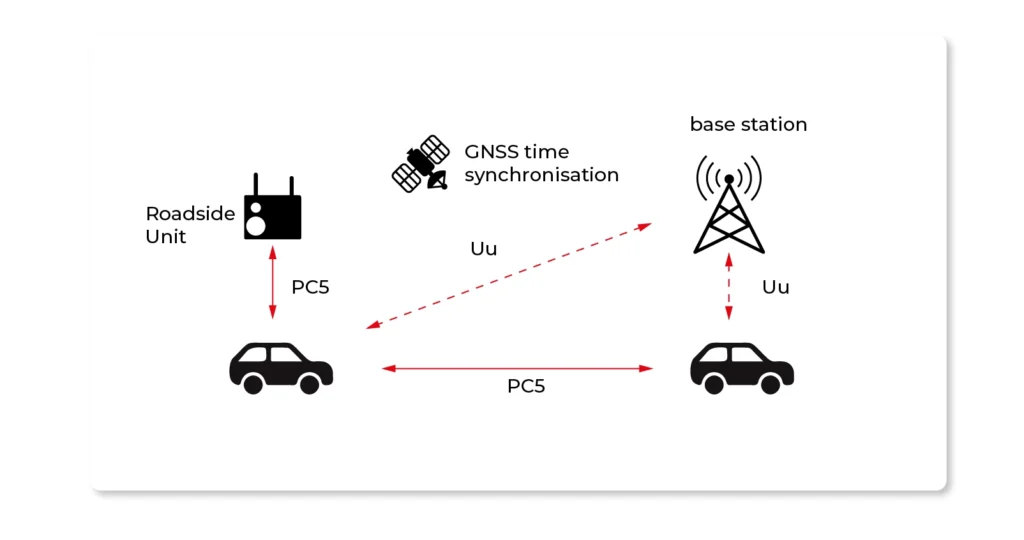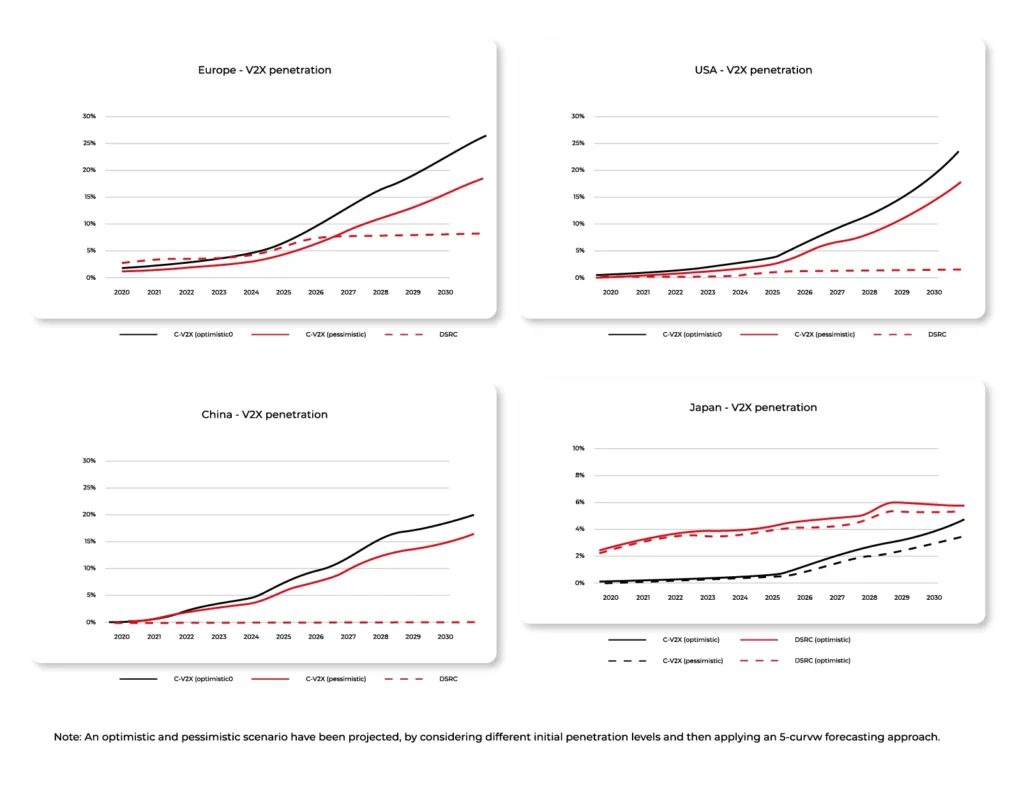
Technology that allows vehicles to communicate wirelessly with other vehicles and road infrastructure is the go-to solution of the future. Regrettably, for the time being, the business justification for V2X roll-out by most OEMs remains beyond reach. What are the prospects for the coming years and what can be done to bring the vision of mass V2X implementation closer?
The role of V2X in supporting ADAS and AV
To begin with the basics, let’s explore the dynamics of change today when it comes to automation in the automotive industry.
The relationship between ADAS (i.e., the systems that currently prevail) and V2X (new type systems) is best captured in the chart below. It shows that the higher the SAE automation levels are, the more the role of V2X technology is emphasized.

Levels 0 to 2 represent the dominance of old-style, sensor-based security systems. Higher levels of automation are already more oriented toward extensive collaboration:
- Between vehicles,
- Between vehicles and infrastructure.
Advanced Driver Assistance Systems (ADAS) for the past 20 years have relied mainly on elements such as onboard sensors (cameras, radars, ultrasound). Low-level automation worked for a while, but it has its shortcomings. Primarily it is about its maximum range, which is only up to 200 meters. The other thing is its low performance in contact with obstacles, such as blind bends and densely parked vehicles.
Meanwhile, sensing technologies have developed so widely that today it is possible to fully collaborate in such configurations as:
- V2V – Vehicle-to-Vehicle.
- V2D – Vehicle-to-device.
- V2P – Vehicle-to-pedestrian.
- V2H – Vehicle-to-home.
- V2G – Vehicle-to-grid.
- V2I – Vehicle-to-Infrastructure.
The most optimistic scenario assumes, among other things, that most vehicles will be able to connect with each other on highways. And this will markedly increase road safety.
Does this mean that as automotive development continues, V2X will replace existing ADAS solutions? Not necessarily. Yet, it is possible that V2X will greatly expand the applications of current and future driver assistance systems. Thus, it will facilitate reaching greater levels of vehicle autonomy.
V2X: benefits and unique selling points
V2X technology, which enables vehicle-to-vehicle and vehicle-to-infrastructure information exchange, is considered a resource worth having and developing in any automotive company. This is chiefly due to the numerous benefits that can be achieved in terms of traffic efficiency and safety. Here are just some of them.
- Addressing the LoS(Lack of Sight) problem which involves the non-visibility of another object. V2X can even detect elements that are invisible or undetectable by traditional sensors. This includes “blind spots” in the side mirror or objects behind a sharp bend.
- Early warning. Drivers of connected vehicles learn in a timely manner about dangers on multi-lane roads, especially high-speed roads. This allows them to react to the problem at an early stage. It is advisable to know that a vehicle’s ABS system is activated within 1 mile of another vehicle equipped with V2X.
- Reducing congestion and streamlining traffic. With the technology described here, such modern fleet management methods as platooning can be successfully applied (see the following paragraphs for more details on this thread).
- Driving assistance even in adverse weather conditions. Fog interferes with ” standard” sensors, such as cameras. Meanwhile, the V2X also performs well during limited visibility.
- Efficient alerting. Approaching emergency vehicles can signal their presence from a great distance. Drivers are therefore able to quickly form an emergency lane on the highway.
- Attaining higher levels of vehicle autonomy. Partially autonomous vehicles perform well in a wide range of scenarios on the road (including merging scenarios).
Are there any limitations when implementing V2X?
One of the obstacles facing OEMs at this point is insufficient demand. Although the technology is up and running and there are already many use cases around the world, consumers are reluctant to pay extra for it. This is happening for a good reason.
For example, most customers don’t understand why they should pay extra for safety-related functionalities. These are already regulated by law anyway, and besides, they are guaranteed as part of ADAS (and these systems are already included in the basic vehicle price). Let’s also bear in mind that a high level of data penetration in a car is not always possible. Most cars are still not high-tech enough. Many features would therefore simply be unavailable. So – why should we incur the cost of it anyway?
Beyond that, there is a long delay between the availability of the technology and the existence of a sufficient number of cars equipped with it. Meanwhile, to talk about V2X on a large scale, these two factors must exist in parallel.
Also, the road infrastructure is not necessarily designed to handle V2X. City authorities still have to focus on “putting out the current fires,” so technological development sometimes takes a back seat. Besides, not all of the city’s road investment is being carried out at the same time due to limited funds.
Of course, in the long run, safer roads and less congestion are the goal worth achieving, but things can’t be done all at once. Examples from specific regions of the world, described in the following paragraphs, in fact, illustrate this point well.
DSRC vs. C-V2X
In the framework of V2X, there are two competing technology solutions:
DSRC – Dedicated Short-Range Communication
A form of wireless communication technology defined by the 802.11p standard. It is essentially an amendment to the IEEE 802.11 (WLAN) standard that defines changes and enhancements in order to effectively support Intelligent Transport Systems (ITS).

C-V2X – Cellular – V2X
A form of a wireless communication solution using mobile network technology. C-V2X has two modes of operation: PC5 (Direct communication) and Uu (Indirect method of communication using a cellular network).

Implementation of systems in specified regions of the world
After decades of development of the aforementioned technology, it is slowly becoming apparent that DSRC is giving way to the popularity of C-V2X. Although the former system still dominates in Europe and the US, this will certainly not last forever. According to experts, before long US and European OEMs will prefer C-V2X in their vehicles exclusively. For the time being, however, both solutions are operating equally in these markets.
This is quite different from China, where the use of Cellular V2X has been embraced without question. For what it’s worth, the issue is a bit more complicated in another Asian region, namely Japan, where DSRC-based ETC (electronic toll collection) has been under development for many years. In the Land of the Cherry Blossom, there is uncertainty about which way to eventually head. Cautious predictions, however, point to a slow transition to C-V2X.

Fundamentals for developing V2X
One thing to realize with V2X is that the benefits are spread across all traffic users. For this to happen, however, some key driving forces are needed for the introduction and market adoption of this technology. These are:
- Platooning.
- Fuel efficiency.
- Smart cities.
- Driver and pedestrian safety.
Trucks moving in a single formation is an environmentally friendly and commercially viable solution. But what does it have in common with V2X? Quite a lot, because for platooning to take place, advanced communications technology is a must.
V2X allows trucks in a platoon to coordinate braking and acceleration among each other. It also makes it possible to perform many complex maneuvers.
Main beneficiaries
Carriers, fleet operators and the entire logistics industry, in general, would benefit enormously from V2X technology. This would not only optimize the transportation costs themselves but also fit in with increasingly stringent emissions standards.
Governments around the world strive to reduce their environmental impact by cutting emissions. In Europe, for instance, the EC Strategy on Sustainable and Smart Mobility is being prepared, outlining plans to reduce them by up to 90 (!) percent by 2050. To achieve this goal, policymakers are looking for technologies that help comply with the aforementioned limits. V2X shows huge potential in this regard.
Example? Solutions such as GLOSA (green light speed optimization) minimize the need for a car to come to a complete stop just before traffic lights and then restart the engine or accelerate. Consequently, fuel consumption and harmful gas emissions are reduced.
Main beneficiaries
Environmental policymakers and regulators are (and will be) under mounting pressure related to emissions. V2X can play a key role in this puzzle, and it is up to policymakers to adopt and implement this technology.
The advantages of the aforementioned technology, however, can also be enjoyed by OEMs. Since V2X reduces fuel consumption, the driver spends less on a monthly basis. Such information can be quoted in marketing communications.
The idea of a smart city is based on interconnected technologies and systems for collecting and using data. So it is quite natural that for functioning, smart cities need V2K solutions.
They enable communication between vehicles and buildings, signals, pedestrians, and other road users. All information is transmitted in real-time, so you gain greater awareness of your surroundings and current needs. More broadly, such intelligent transportation and road infrastructure management systems help reduce congestion. Noise levels, pollution in densely populated areas, and the likelihood of collisions are also curbed.
Automated urban logistics is the future of urbanization – without any doubt.
Main beneficiaries
Connected through VCX, a smart urban area can offer many benefits not only for overall security, but also for local commerce and the quality of life for its residents.
City authorities can plan individual processes more efficiently, resulting in real savings. In a potential scenario, city-funded traffic operators are immediately notified of incidents via V2X and smart cameras. By doing so, they warn other road users of the danger or make an instant decision to set up a detour. If necessary, they prioritize emergency vehicles.
Urban businesses are also enjoying the perks of a V2X-equipped smart city. That’s because they benefit from shorter times for transporting goods from the place of manufacture to the point of trade. This is due to less congestion on the roads, intelligent route planning, and fully automated city logistics.
- Driver and pedestrian safety
Traffic collisions, injuries, and deaths not only incur unit costs but also seriously drain the public budget.
The solution to these problems may lie exactly in V2X technology, which makes it possible to identify more hazards on the road than ever before. Drivers can react more quickly to dangerous maneuvers by other road users and make early decisions that could potentially affect someone’s health or life.
Main beneficiaries
Consumer purchasing power and public opinion certainly have a bearing on the success of V2X deployment. If road users understand that such solutions actually contribute to safety, they will be eager to push them.
Local politicians will also benefit from the achievements of new connected vehicle technologies. They, in fact, often base their election campaigns on claims related to reducing road accidents in their regions. And V2X is helping to fulfill those promises.
An important question to be answered is who will ultimately be responsible for the introduction and development of V2X. And who will begin to do it on a large scale. The answer is not straightforward.
From the very outset, cities are faced with the difficult task of making significant infrastructure investments. For this, funds have to be obtained at some point, especially since once implemented solutions still have to be sustained. Certainly, though, the benefits associated with V2X are well worth the funds expended on this technology.
On the other hand, we have OEMs that need a trigger to push their products forward. This must be fostered by the right market environment (a sufficient number of vehicles with V2X capabilities) and the commitment of the authorities responsible for maintaining public infrastructure. At this point, there are also constraints related to consumer reluctance, e.g. in the face of excessively high vehicle data penetration rates.
So, it all boils down to goodwill, openness to change, and the fact that certain technologies need to mature on the market.




